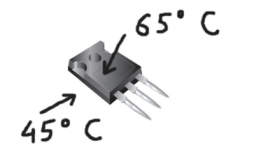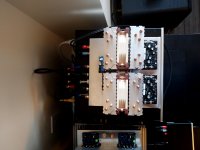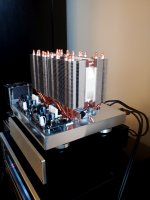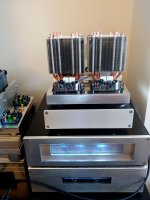Well done Andy and I admire your perseverance in getting it working. Make sure it is all fine when Hugh finally calls around to have a listen.
Enjoy it immensely and now what will your next project be after tackling one of the harder builds?
Enjoy it immensely and now what will your next project be after tackling one of the harder builds?
Congratulations to your AN build, Andy!
Thank you, meanie. 🙂
Sitting down listening to the AN 4R driving my 2 ohm ribbons. (Louder than I normally listen.)
The Shehedrin ballet version of Bizet's "Carmen" - for strings and percussion.
Very dynamic piece - but still no red LEDs flashing! So I think I will have to get my sig-gen & CRO up here in the 'listening room' ... and use a 2.5 ohm dummy load, in order to drive the amp into clipping. 😀
(I just want to satisfy myself that the red LEDs are working OK (seeing as how I blew one of the green LEDs by too much soldering ... or too long with the heat gun, on the heatshrink over the LED leads). 😱 )
A very minor increase in temperatures, driving 2 ohms instead of 3.2 ohms - a couple of degrees C, only.
Andy
Well done Andy and I admire your perseverance in getting it working. Make sure it is all fine when Hugh finally calls around to have a listen.
Enjoy it immensely and now what will your next project be after tackling one of the harder builds?
Thank you, Gary - and, most importantly, for your instructions on how to deal with the *!@% SMD components! 🙂
Having proved that the AN 4R handles my 2 ohm ribbons without any problems, all I need to do now - to get it finished for Hugh - is:
1. solder the Active mains wires which go to each traffo, to their respective NTC.
2. install the Binding Posts and remove the temporary spkr cables.
3. use a CRO, sig-gen & dummy load to get the red 'clip LEDs' to fire.
But then I really need to build AN 4R #2 - so we can listen to ANs driving my mids and ribbons in both channels. That's my next project - and B]then [/B]it will be appropriate for Hugh to come round for a listen. 🙂
Andy
Hi Andy,
If you just connect your DVM to the speaker outs (with speaker attached) and see about what AC voltages you are hitting, that will tell you if the clip lights should be flashing. I forget what your max rail voltages are but take the +/-Vpp possible from your PSU rails and divide by 2.83 and that should be about the value you need to hit on the DVM to get the lights to blink. So for 24v rails that’s 48v/2.83 or about 17vrms. Which is going to be darned loud at 2ohms. I actually think it’s easier to clip at higher impedance. 17Vrms into 2ohms is 140w. So it will probably be clipping closer to 120w. Still very loud.
If you just connect your DVM to the speaker outs (with speaker attached) and see about what AC voltages you are hitting, that will tell you if the clip lights should be flashing. I forget what your max rail voltages are but take the +/-Vpp possible from your PSU rails and divide by 2.83 and that should be about the value you need to hit on the DVM to get the lights to blink. So for 24v rails that’s 48v/2.83 or about 17vrms. Which is going to be darned loud at 2ohms. I actually think it’s easier to clip at higher impedance. 17Vrms into 2ohms is 140w. So it will probably be clipping closer to 120w. Still very loud.
Take Some Risk
Well, today I finished all the wiring up and fired up the first AN 4R. No magic smoke! 😊 Yay!
One heatsink is running slightly hotter than the other – is that a problem? Also the 2x 8D-20s (one on the primary of each traffo) run very hot – too hot to pinch between finger and thumb, for long!
Don't worry to much about the heat..
Set the fan speed that you get a maximum heat inside the box when it is closed and it has been run for one hour not exceeds 80C.. if you like it cooler then just give some more speed to the fans, but within "the not hear able noise Range".
Talking of 15db. A good fan should run about 600 RPM not making more than that noise and this you will not hear if you do not glue your Ear just beside the fan.
Best heat dissipation for the kind of heat sinks is when this have flowing air under neat. so I suppose the fans are under neat. I also use this kind of thinks. and I assure you this are almost the best you can get.
My Class A runs with +- 42 Volts and 4Ampere IDLE using single end, transistor config . With the FAN on the Side mounted it keeps the heat at 50C. but its not inside the box. So this will be about 75C for when the Amp goes into its box. I can not Upload Pictures here, only a link so I leave it.. The RE of my Class A get's a 120 - 140C even if its out of the BOX it. but it's still within the Limits of the Resistor Manufacturer. it a 200Watt R.
Last but not least, Try to reduce wire, for myself too much
Looks good BTW.
Hi Andy,
If you just connect your DVM to the speaker outs (with speaker attached) and see about what AC voltages you are hitting, that will tell you if the clip lights should be flashing. I forget what your max rail voltages are but take the +/-Vpp possible from your PSU rails and divide by 2.83 and that should be about the value you need to hit on the DVM to get the lights to blink. So for 24v rails that’s 48v/2.83 or about 17vrms. Which is going to be darned loud at 2ohms. I actually think it’s easier to clip at higher impedance. 17Vrms into 2ohms is 140w. So it will probably be clipping closer to 120w. Still very loud.
Thanks very much for the explanation, X. Yes, I suspect I will need to go loud! Maggie ribbons are not very robust - hence I would much prefer to use a 2.5 ohm dummy load (4x 10 ohm/10w ceramic reses in parallel) and a sig-gen ... than trust I wouldn't blow a ribbon.
But what you've said gives me another idea! 🙂 I could use my AN 4R on my bass panels - which:
a. are 4 ohms, and
b. are very robust.
So turning it up until the LEDs come on ... will not be a problem to the bass drivers! 🙂 (I normally drive them with Hugh Dean 100w 'Soraya' monoblocs.)
My DC rails are a tad less than 22v - which means 44/2.83 = 15.5v
Thanks again,
Andy
Looks good BTW.
Thanks, hpro. 🙂
Best heat dissipation for the kind of heat sinks is when this has flowing air underneath. so I suppose the fans are underneath. I also use this kind of things. and I assure you this are almost the best you can get.
Yes - there is a 92mm diam hole in the base of the case, directly underneath each 92mm Noctua fan.
My Class A runs with +- 42 Volts and 4Ampere IDLE using single end, transistor config.
Wow! A serious heat load! (Mine is +/- 22v and ~3a bias current.)
Last but not least, Try to reduce wire, for myself too much
Sorry, hpro - I don't understand what you're getting at, here? 🙁
Andy
Verrrry interesting! 🙂
Still listening to the the AN on the ribbons (frequ range 4K and up). The music seems more full-bodied and organic than yesterday, when I had NAKSA 80s on the ribbons and the AN 4R on the mids. (Maybe it's just the PS caps running in a bit?)
Can't wait to be able to listen with the 2nd AN 4R in the system! 🙂
Andy
Still listening to the the AN on the ribbons (frequ range 4K and up). The music seems more full-bodied and organic than yesterday, when I had NAKSA 80s on the ribbons and the AN 4R on the mids. (Maybe it's just the PS caps running in a bit?)
Can't wait to be able to listen with the 2nd AN 4R in the system! 🙂
Andy
Another interesting point:
* R3, R4, R5 & R6 on the SLBs (all 0.1R) are running at about 50-53 deg C
* R141 & R142 on the AN board (0.12R for the 4R circuit) are running at about 40-43 deg.
Andy
* R3, R4, R5 & R6 on the SLBs (all 0.1R) are running at about 50-53 deg C
* R141 & R142 on the AN board (0.12R for the 4R circuit) are running at about 40-43 deg.
Andy
I finished proper PSU for AN - I cased two HP 230W laptop bricks, so I'm playing it right now.
Still excellent sound 🙂
I did more temperature measurements, and I have one observation:
a) when measuring FET temp on the BACK of the case: 64 degrees
b) when measuring FET temp on the SIDE of the case: 44 degrees
Well, that makes it two, not one.
See picture.
20 degrees difference! Wouldn't suspect..
I guess distance from the plastic surface to the die matters!
Or it's the way the infrared thermometer "sees" the smaller vs bigger surface?
These temps registered 20 minutes after start, they will crawl closer to 70 degrees later on, and they are measured with infrared device,
that is confirmed to be fairly accurate.
I suspect if I measure temp on the 'narrow' side, behind the hole, the temperature might be even lower..
Also made an experiment to run it without fans.
Of course whole chassis and CPU heatsinks got really HOT, close to the temp of the fets 🙂
So these these little, quiet fans actually work pretty well..
I'm upgrading them to 4pin Noctua fans.
Still excellent sound 🙂
I did more temperature measurements, and I have one observation:
a) when measuring FET temp on the BACK of the case: 64 degrees
b) when measuring FET temp on the SIDE of the case: 44 degrees
Well, that makes it two, not one.
See picture.
20 degrees difference! Wouldn't suspect..
I guess distance from the plastic surface to the die matters!
Or it's the way the infrared thermometer "sees" the smaller vs bigger surface?
These temps registered 20 minutes after start, they will crawl closer to 70 degrees later on, and they are measured with infrared device,
that is confirmed to be fairly accurate.
I suspect if I measure temp on the 'narrow' side, behind the hole, the temperature might be even lower..
Also made an experiment to run it without fans.
Of course whole chassis and CPU heatsinks got really HOT, close to the temp of the fets 🙂
So these these little, quiet fans actually work pretty well..
I'm upgrading them to 4pin Noctua fans.
Attachments
Last edited:
I finished proper PSU for AN - I cased two HP 230W laptop bricks, so I'm playing it right now.
Still excellent sound 🙂
I did more temperature measurements, and I have one observation:
a) when measuring FET temp on the BACK of the case: 64 degrees
b) when measuring FET temp on the SIDE of the case: 44 degrees
Well, that makes it two, not one.
See picture.
20 degrees difference! Wouldn't suspect..
I guess distance from the plastic surface to the die matters!
Or it's the way the infrared thermometer "sees" the smaller vs bigger surface?
These temps registered 20 minutes after start, they will crawl closer to 70 degrees later on, and they are measured with infrared device,
that is confirmed to be fairly accurate.
I suspect if I measure temp on the 'narrow' side, behind the hole, the temperature might be even lower..
Also made an experiment to run it without fans.
Of course whole chassis and CPU heatsinks got really HOT, close to the temp of the fets 🙂
So these these little, quiet fans actually work pretty well..
I'm upgrading them to 4pin Noctua fans.
I see about 62-65 after an hour or so, without any air moving. When they are placed in the dedicated room, there is an air column (adjustable volume and temp) that cools all components, I set it up when I built the room.
Here are the final photos.
AN is on top of small Alu box without VU meters - that's AN's
PSU.
Below it's my other two PSUs, that are used for all other amps -
the one with lights on is handling output (speaker protection and VUs) for AN.
It's not really needed - I could plug speakers directly to AN, but I want to use
protection...
New, 4-pins Noctua fans are actually controlled by the temperature sensor (it turned out
that previous 3-pin fans were not!), and they are running slightly faster than old ones.
As a result, FET's temperature of in low 60s, and they are also dead quiet.
These VU meters are from burned out Technics chip amp and from dead Akai tape player..
AN is on top of small Alu box without VU meters - that's AN's
PSU.
Below it's my other two PSUs, that are used for all other amps -
the one with lights on is handling output (speaker protection and VUs) for AN.
It's not really needed - I could plug speakers directly to AN, but I want to use
protection...
New, 4-pins Noctua fans are actually controlled by the temperature sensor (it turned out
that previous 3-pin fans were not!), and they are running slightly faster than old ones.
As a result, FET's temperature of in low 60s, and they are also dead quiet.
These VU meters are from burned out Technics chip amp and from dead Akai tape player..
Attachments
Last edited:
Thanks JT!I love it... Seriously, great look.
JT
I'm building two more ANs like this for friends..
Waiting for 4 more HP bricks (model hstnn-da12) - only $18 each, and they
are very good quality PSUs; and for Alu box enclosures for them.
The hardest part is milling aluminum for the chassis 🙂
Last edited:
I finished proper PSU for AN - I cased two HP 230W laptop bricks, so I'm playing it right now.
Still excellent sound 🙂
I did more temperature measurements, and I have one observation:
a) when measuring FET temp on the BACK of the case: 64 degrees
b) when measuring FET temp on the SIDE of the case: 44 degrees
Well, that makes it two, not one.
See picture.
20 degrees difference! Wouldn't suspect..
I guess distance from the plastic surface to the die matters!
Or it's the way the infrared thermometer "sees" the smaller vs bigger surface?
These temps registered 20 minutes after start, they will crawl closer to 70 degrees later on, and they are measured with infrared device,
that is confirmed to be fairly accurate.
I suspect if I measure temp on the 'narrow' side, behind the hole, the temperature might be even lower..
Also made an experiment to run it without fans.
Of course whole chassis and CPU heatsinks got really HOT, close to the temp of the fets 🙂
So these these little, quiet fans actually work pretty well..
I'm upgrading them to 4pin Noctua fans.
Most of the reasonably priced IR thermometers out there do not like shiny surfaces and also they have a much larger area that they “look at” then the led indicator light. The area gets larger as you move the thermometer away from what you are measuring. So if the area of the device is small, like the side of that mosfet, it will be a smaller part of the overall picture that the thermometer sees, and since the fet is the hottest thing in the picture, the temperature indicated will be averaged downwards.
So, I would tend to believe the higher reading taken from the front of the mosfet.
Fantastic build, by the way. Art and technology as one!
What's the dif in temps fore and aft?
Can't measure it, have no access to the narrow back edge of the fet...
Can only measure 'upper' back, and one side.
Really cool Alpha Nirvana Minek123!! Housing the power supply in a separate chassis makes it so compact, nice. Get yourself a 3 or 4 inch soft bristle paintbrush to clean the dust from your “open” concept amps. You can gently brush in all the nooks and crannies to remove the dust that can build up from the fans. And it keeps them nice and shiny 😀
Congrats!

Congrats!

- Home
- Amplifiers
- Solid State
- Alpha Nirvana 39w 8ohm Class A Amp



